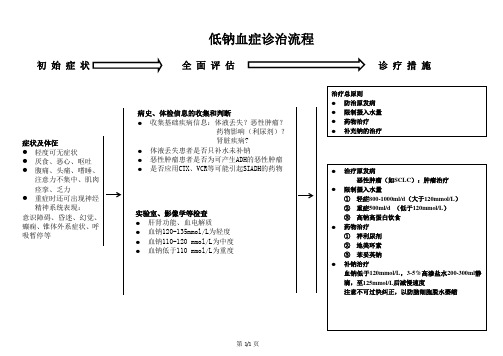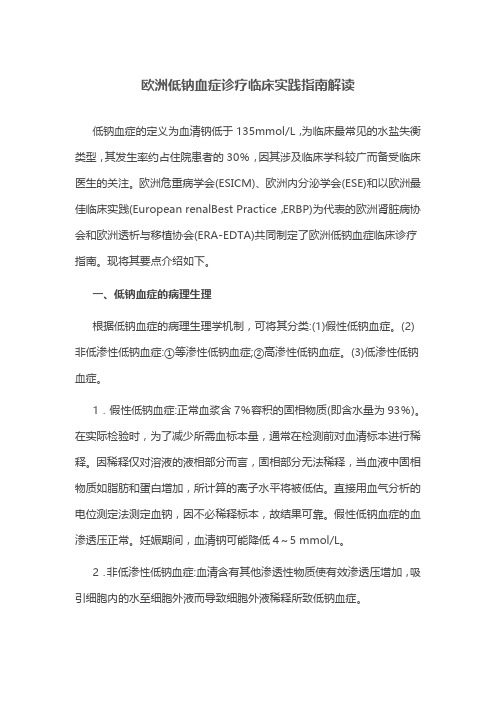2014欧洲低钠血症诊疗指南
钠代谢紊乱

常伴有Sepsis:感染表现+SOFA量表≥2,可诊断。广谱抗生素强化抗感染。
水、钠平衡的调节
渗透压由所含的微粒总数决定,胶体渗透压维持血容量,晶体渗透压维持细胞内外水平衡。
水平衡的调节:渴感、抗利尿激素(ADH) 钠平衡的调节:醛固酮、BNP
血渗透压的调节:渗透压变化1%→刺激下丘脑、颈内动脉的渗透压感受
① 纠正速度无需限制,纠正过快时无需再降血钠; ②立即升高4-6mmol/l,尤其是颅高压症状、昏迷者; ③症状重者:3%NaCl 100ml静推(10分钟以上), 轻中度症状: 3%NaCl静滴(0.5-2ml/kg/h)。
托伐普坦(苏麦卡):V2受体拮抗剂 15mg qd ①多用于SIADH,心衰患者。 ②排除低血容量低钠;不限液;不联用。 ③严重肝、肾功能障碍的不用。 ④不用于症状严重的低钠血症(因起效比高渗
低钠血症多是ADH绝对量的增减或和V2受体的结合力异常所致。
高渗性脱水以补糖为主,先糖后盐。
高钠血症
病因:1、钠摄入过多。水摄入不足。
2、水转移到细胞内。细胞内小分子增多,细胞内渗透压升高。
可见于:过度锻炼、癫痫、乳酸酸中毒。
3、水丢失过多。经肾或非经肾丢失,如:消化液丢失、昏迷及
出汗、渗透性利尿、尿崩症、下丘脑损伤。
D-二聚体升高时是否需抗凝治疗?
HHS(高渗性高血糖状态)来自↗ 肾功能受损高血糖 → 渗透性利尿 → 脱水 → 高渗状态、高钠血症
↘ 血栓形成
以严重高血糖、血浆渗透压明显升高、失水及意识障碍为特征。
病死率>40%,死亡率为DKA的10倍以上,脑细胞脱水是死亡的主要原因。
实验室诊断标准,血糖≧33.3mmol/l,尿糖强阳性,尿酮阴性。 血钠=实测值-0.3(血糖值-5.6) 大多数患者白细胞数升高;如明显升高超过25*109/L,提示感染存在。
低钠血症诊断与治疗临床实践指南

无中重度症状的 急性低钠血症 (3)
循环血容量不足?
低容量的 慢性低钠血症 (4) 是
否
细胞外液量增多?
是 SIADH (6)
否
高容量的 慢性低钠血症 (5)
严重症状?
是 症状严重的低钠血症 (1) 否
低钠血症的治疗流程
(1)症状严重的低钠血症 中度症状?
•第一小时:
20分钟 否 是 •150ml 3%高张钠 静脉输注 •20分钟后复测血Na •可重复输注 急性低钠血症? •目标: 血Na↑5mmol/l
>100mOsm/kg
≤100mOsm/kg
3
≤30mmol/L 有效动脉血容量不足
•原发性烦渴 •盐摄入不足 •嗜酒
尿钠浓度
>30mmol/L
利尿剂或肾脏病
低钠血症
低钠血症的诊断流程
<275mOsm/kg
血渗透压
1
除外高血糖和其他原因造成的非低渗性低钠血症 低渗性低钠血症
急性或严重症状
是
立即开始高张钠盐治疗
低钠血症在住院患者中的发病率达30%,轻度低钠血症的并发症有行动 不便和认知损害,以及骨质疏松症和骨折
Contents
几个分类定义
诊断流程
治疗流程
低钠血症
低钠血症的诊断流程
<275mOsm/kg
1
除外高血糖和其他原因造成的非低渗性低钠血症 低渗性低钠血症
急性或严重症状
是
立即开始高张钠盐治疗
否
2
尿渗透压
容量评估 补液试验
急性或严重症状
是
立即开始高张钠盐治疗
否
2
尿渗透压
>100mOsm/kg
低钠血症

2 中重度低钠血症
立即开始诊断评估
如果可能,停止引起低钠血症的所有治疗
推荐病因治疗 立即单次输注3%盐水(或等量)150ml,20分钟以上
每24h血钠升高5mmol/l
第1个24h血钠升高<10mmol/l 之后每日血钠升高<8mmol/l 第1、6、12h检测血钠 如果血钠上升而症状无改善,应寻找其他原因
大脑通过减少其细胞内渗透活性物质如
钾和有机溶质以试图恢复脑容量。此过
程需时24~48小时。
低钠血症的症状
严重症状--脑水肿 慢性、无明显症状者:步态不稳,跌倒,注意 力不集中和认知障碍 慢性患者更易发生骨质疏松和骨折
根据症状分类
(注意力不集中) 中度症状 恶心 意识混乱 头痛 重度症状 呕吐 心脏呼吸窘迫 嗜睡 癫痫样发作 昏迷(Glasgow评分≤8)
容量状态的临床评估
根据临床评估容量状态敏感性(0.5–0.8)及特 异性(0.3–0.5)均较低 当采用血容量状态临床评估策略时,临床医生 似乎常常错误的进行低钠血症归类
使用尿渗透压及尿钠浓度评估策略优于临床容 量状态评估
使用尿渗透压及尿钠浓度评估策略的培训医生 的诊断结果好于不使用该策略的高年医生
血糖增高,血钠浓度校正公式
校正血钠浓度(mg/dl)= 实测血钠浓度(mg/dl)+
校正血钠浓度(mg/dl)= 实测血钠浓度(mg/dl)+ * Na:mg/dL×0.435→mmol/L
低渗性低钠血症的常用参数
血清渗透压测定 血清钠浓度 尿渗透压 血容量评估指标 尿钠浓度 需要同时采取血和尿标本方可对实验室 结果做出正确解释 尿钠浓度和尿渗透压测定最好取自同一 标本
低钠血症医学

原因和机制?
• 等容性低钠血症主要见于ADH分泌异常综 合症。
1. 恶性肿瘤:多见于支气管、胰腺、十二指 肠、输尿管、前列腺等癌症。
2. 中枢神经系统疾病:创伤、感染等。 3. 肺部疾病:结核病、肺炎、真菌感染、肺
脓肿、正压人工呼吸等。 • 上述原因可在不同程度上造成ADH旳异常
释放。
等容量性低钠血症对机体旳影响
低容量性低钠血症旳治疗原则
• 防治原发病,清除病因。 • 对症补液:原则上予以等渗液以恢复细胞
外液容量。需补钠量=[正常血钠值( mmol/L)-测得血钠值(mmol/L)] ×体重 (Kg)×0.6(女性为0.5) • 如出现休克,要按休克旳处理方式主动急 救。
(二)高容量性低钠血症
• 定义:高容量性低钠血症特点就是血钠下
Thank You !
,并同步用高效利尿剂促使水旳排出,以 降低细胞外液容量,然后用高渗盐水补充 血清钠,恢复钠离子水平和细胞内外液体 平衡。
低钠血症旳护理措施?
• (1)动态监测血钠、尿钠旳变化。
• (2)正确合理补液:根据不同类型旳低钠血 症,遵医嘱选择合适旳补液原则。
• (3)加强健康教育和基础护理 :向患者及家 眷简介低钠血症旳主要临床体现、治疗及 护理措施非常主要。有旳患者及家眷对反 复旳抽血及保存尿液不了解,护士耐心细 致旳告诉患者这些操作是为医生旳诊疗和 治疗提供根据旳,以取得患者及家眷旳了 解,稳定情绪,主动配合治疗和护理。
降,血清Na+浓度<135mmol/L,血浆渗透压 <280mmol/L,但体钠总量正常或增多,患 者有水潴留使体液量明显增多。也可称为 水中毒。
原因和机制?
主要原因是因为过多旳低渗性体液在 体内潴留造成细胞内外液量都增多,引起 主要器官功能严重障碍。
低钠血症的诊断与治疗

中度症状低钠血症的治疗 (1)中度症状低钠血症应给予有限的高渗盐水、等渗盐水、口服钠盐、限水或普坦类药物治疗。 (2)寻找病因 (3)如果对因治疗中血钠进行性下降,建议如严重症状低钠血症一样管理。
无或轻度症状的慢性低钠血症的治疗 (1)不推荐以单纯升高血钠浓度为目标的治疗。 (2) 去除诱因、限水,停用可能引起低钠血症的药物或其他因素。
对因治疗
低容量性慢性低钠血症:以恢复细胞外容量治疗为主(补液--等渗盐水),对因治疗(停用导致低钠药 物,应用氢化可的松纠正盐皮质激素缺乏);
高容量性慢性低钠血症:以限制液体量,应用袢利尿剂,控制原发病,必要时使用普坦类药物治疗;
等容量性慢性低钠血症:对因治疗(停用导致低钠药物,激素缺乏的行替代治疗),限制液体量,普坦 类药物
慢性低钠血症过度纠正处理: (1)如果24 h血钠增加幅度>10 mmol /L,48 h>18 mmol /L,建议立即采取措施降低血钠并停止积极的补钠 治疗;
(2)在严密监测尿量和液体平衡的情况下口服补充水分或输注10 ml/kg 5%葡萄糖溶液,输注速度3 ml·kg·h -1;
(3)持续输液治疗,每小时复测血钠水平,直至血钠降至目标值;
(4)上述处理仍不能改善,可以考虑给予糖皮质激素(如地塞米松4 mg q6h)治疗24~48 h。
总结
低钠血症
排除高血糖及其他原因所 致的非低渗性低钠血症
低渗性低钠血症
症状是否紧急
是
立即治疗
心衰、肝硬 化、肾综
容量 增加
精神性多饮
否
>100
正常 容量
尿渗透压
<100
容量
经过体表、消化道、
下降
肾脏丢失
血流动力学及血管活性药物应用

1.有创动脉压监测
• 用Allen’s 试验法判断来自尺动脉掌浅弓的血流是否足够。
1.抬高前臂,术者用双手拇指分别摸到桡、尺动脉搏动。 2.嘱患者做3 次握拳和松拳动作,压迫阻断桡、尺动脉血流,直至手 部变苍白。 3.放平前臂,只解除尺动脉压迫,观察手部转红的时间。正常为< 5s~7s;0s~7s 表示常弓侧支循环良好;8s~15s 属可疑;>15s 属掌弓侧支循环不良,禁忌选用桡动脉穿刺插管。
动脉导管——ABP
有创血压监测:循环系统常规和重要的监测项目,评
定循环功能重要指标,反映心肌收缩和 血管内容量适宜与否依据
用于穿刺插管的动脉:桡动脉、足背动脉
肱动脉、股动脉等
2.中心静脉压监测
• CVP是通过装满液体的管道将血管腔与外部压力 换能器相连接而测得。多选择上腔静脉与右心房 连接处血管内腔隙进行监测。代表上、下腔静脉 胸腔段和右心房的压力。 • 正常值:5~10cmH2O • 生理意义:<5mmHg提示血容量不足, >5~20mmHg提示输液过多或心功能不全。
⑤对新出现的心前区收缩期杂音的判别。
5、肺动脉栓塞:正常时肺动脉舒张末压仅较平均PAWP略高,若差6mmHg以上,表示肺小动脉与肺 微血管存在明显阻力。如能排除由慢性肺心病、肺纤维化或其他原因引起者,应考虑肺动脉栓 塞。
4.脉搏指示剂连续心排血量
• PiCCO:是一种新的脉搏轮廓连续心排血量与经肺温度稀 释心排血量联合应用技术, PiCCO 技术在热稀释测量的同 时,分析动脉脉搏轮廓并计算出主动脉顺应性。 根据校正 动脉脉搏轮廓公式,计算个体化的每搏量(SV)、心输出 量(CCO)和每搏量变异(SVV),以达到多数据联合应 用监测血流动力学变化的目的。
CVP低≠ 血容量不足
2014欧洲低钠血症诊疗指南

环磷酰胺(IV)
催产素 最近开始去氨加压素治疗 最近开始特利加压素,加压素
根据症状分类: 6131:中度症状 恶心 意识混乱 头痛 6132:重度症状 呕吐 心脏呼吸窘迫 嗜睡 癫痫样发作 昏迷(Glasgow评分≤8)
低钠血症
Hyponatraemia, defined as a serum sodium concentration< 135 mmol/l, is the most common disorder of body fluid and electrolyte balance encountered in clinical practice. It occurs in up to 30% of hospitalised patients and can lead to a wide spectrum of clinical symptoms, from subtle to severe or even life threatening (10, 11)
6.3 区别低渗性低钠血症的参数?
6.3.1.1 首先检测并解释尿渗透压 6.3.1.2 如果尿渗透压≤100 mOsm/kg,可认为水摄入相对过量是 低渗性低钠血症的原因。 6.3.1.3 如果尿渗透压> 100 mOsm/kg,推荐同时在采取血液标本 的基础上解释尿钠浓度。 6.3.1.4 如果尿钠浓度≤30mmol/l,推 荐接受有效循环血量降低为低渗性 低钠血症的原因 6.3.1.5 如果尿钠浓度> 30mmol/l, 建议评估细胞外液状况和利尿剂的 应用,以进一步明确低钠血症的可 能原因。 6.3.1.6 不建议检测加压素用于诊断 SIADH.
如何维持钠水平衡

如何维持钠水平衡正常人体钠 60% 存在于细胞外液,是细胞外液中的主要阳离子,30% 存在于骨骼中,10% 存在于细胞内液。
血清钠的正常值在 135-145 mmo/L。
低钠血症血清钠浓度低于 135 mmol/L 时称为低钠血症,与机体内总钠量无关。
血清钠 130-135 mmol/L 称为轻度低钠,125-129 mmol/L 为中度低钠,<125 mmol/L 为重度低钠。
补钠量一般可按如下公式(按细胞外液计算):应补氯化钠(g)=[正常血钠(mmol/L)- 实测血钠(mmol/L)]×体重(kg)×0.2/17公式中正常血钠一般按 140 mmol/L 计算,1 g 氯化钠含 17 mmol 钠。
该公式计算出的钠量可能偏低,因总的可交换钠并不是完全存在于细胞外液。
可在 24 h 内先补计算量的 1/3-1/2,复查后再补充。
常用药物生理盐水、5% 葡萄糖氯化钠、碳酸氢钠注射液、高渗盐(3% 氯化钠)、呋塞米等。
补液原则根据 2014 年欧洲低钠血症诊疗临床指南:1. 严重低钠血症第 1 小时:推荐立即静滴 3% 高渗盐水 150 mL 20 min 以上。
20 min 后检查血钠浓度并在第二个 20 min 重复输注 150 mL 高渗盐水。
注意事项:重复以上 2 次直到血钠增加 5 mmol/L。
1 小时后:(1)若血钠升高 5 mmol/L、症状改善时考虑更改高渗盐水为 0.9% 盐水,并维持血钠稳定。
注意事项:第 1 个 24 h 限制血钠升高超过 10 mmol/L,随后每 24 h 升高 <8 mmol/L,直至 130 mmol/L。
(2)1 h 后若血钠升高 5 mmol/L,症状无改善时应继续静脉输注 3% 高渗盐水,使每小时增加 1 mmol/L。
如症状改善、血钠升幅达 10 mmol/L、血钠达 130 mmol/L 三个条件任一则停用高渗盐。
低钠血症诊治流程

实验室、影像学等检查 肝肾功能、血电解质 血钠120-135mmol/L为轻度 血钠110-120 mmol/L为中度 血钠低于110 mmol/L为重度
初始症状
症状及体征 轻度可无症状 厌食、恶心、呕吐 腹痛、头痛、嗜睡、
注意力不集中、肌肉 痉挛、乏力 重症时还可出现神经 精神系统表现: 意识障碍、昏迷、幻觉、 癫痫、锥体外系症状、呼 吸暂停等
低钠血症诊治流程
全面评估
诊疗措施
病史、体检信息的收集和判断 收集基础疾病信息:体液丢失?恶性肿瘤?
治疗总原则 防治原发病 限制摄入水量 药物治疗 补充钠ห้องสมุดไป่ตู้治疗
治疗原发病 恶性肿瘤(如SCLC):肿瘤治疗
限制摄入水量 ① 轻症800-1000ml/d(大于120mmol/L) ② 重症500ml/d (低于120mmol/L) ③ 高钠高蛋白饮食
药物治疗 ① 袢利尿剂 ② 地美环素 ③ 苯妥英钠
补钠治疗 血钠低于120mmol/L,3-5%高渗盐水200-300ml静 滴,至125mmol/L后减慢速度 注意不可过快纠正,以防脑细胞脱水萎缩
第 1/1 页
低钠血症ppt

?原发性烦渴 ?盐摄入不足 ?嗜酒
≤30mmol/L
有效循环血容量不足
>30mmol/L
利尿剂或肾脏病
第十六页,共31页。
低钠血症
低钠血症的诊断(zhěndu
有效除(y外ǒ高u血xi糖à和o)其循他环(qí血tā)容原因量造不成足的非低渗性低钠血症
?细胞外液量增多
?心衰
?肝硬化
低渗性低钠血症
<275mOsm/kg
低渗性低钠血症
<275mOsm/kg
急性( jíxìng)或严重症状 是 立即开始高张钠盐治疗
≤30mmol/L 有效动脉血容量不足
否
2 尿渗透压
>100mOsm/kg
3 尿钠浓度
≤100mOsm/kg
?原发性烦渴
?盐摄入不足
?嗜酒
>30mmol/L
?心衰、肝硬化、 NS ?腹泻呕吐,肠梗阻 etc
淋巴肉瘤等。
? 肺部感染: 肺结核、肺炎、 CO PD 等。
? 中枢神经病变 :外伤、出血、炎症、肿瘤、颈脊髓病变。 ? 药物: 长春新碱、环磷酰胺、卡马西平等。
第二十一页,共31页。
低钠血症的治疗(zhìliá 症状(zhèngzhuàng)严重?
是
否
症状(zhèngzhuàng)严重的严重低
钠血症
第十七页,共31页。
低钠血症
低钠血症的诊断(zhěndu
除外高血糖和其他原因(yuányīn)造成的非低渗性低钠血症
非利尿剂或肾脏病
?呕吐(ǒu tù) ?肾上腺功能不全 低渗性低钠血症
<275mOsm/kg
?肾失盐综合征
?脑性耗盐综合征 ?抗利尿激素急分泌性异或常严综重合症征状
低钠血症治疗指南解读

低钠血症的治疗
+ 慢性低钠血症为48h以上持续低钠血症或血 钠降低<0.5mmol/h
+ 急性低钠血症为低钠血症48h内或血钠降低 >0.5mmol/h
+ 渗透性的脱髓鞘综合征
是一种少见的急性非炎性中枢脱髓鞘性疾病,主要是由于 慢性低钠血症时脑细胞已经适应了一种低渗状态,此时一 旦给予迅速补钠,血浆渗透压迅速升高造成脑组织脱水而 继发脱髓鞘
+ 输入1L 3%氯化钠,血钠可升高(513-120) /(60*0.6+1)=10.6mmol/L
+ 抗利尿激素(ADH)未按血浆渗透压水平而 分泌异常增多,致使体内水分储留、尿钠排 出增加,因而出现稀释性低钠血症等一系列 临床表现的综合征。
+ 肺部肿瘤、胃肠道肿瘤、中枢神经系统炎 症、脑出血等可以引起ADH分泌异常增多。
+ 避免再次使用利尿剂
+ 是以低钠血症和脱水为特征的综合征
+ 颅内肿瘤、颅脑外伤等
+ 引起的下丘脑内分泌功能紊乱导致利钠肽 增多,出现尿钠排泄增加,多尿。
+ 临床特征主要为尿钠增加,低钠血症和低 血容量。
+ 使用等渗盐水纠正低血容量
+ 当患者因低钠血症出现明显的感觉障碍, 可输注高浓度钠溶液,但输注速度不能超 过推荐的速度
低钠血症治疗指南解读
+
+ 低钠血症是临床上最常见的电解质紊乱 + 急性严重的低钠血症可以导致极高的病死率 + 引起低钠血症的病因繁多 + 过度快速的纠正慢性低钠血症可以导致严重的神
经系统并发症,甚至死亡 + 临床表现主要以神经功能障碍为主,
ICU常见疾病指南

AIUM:腹主动脉超声诊断和筛查实践指南(2015
心脏冲击伤临床诊疗规范(建议) 2014年ESC_EACTS 袖珍指南:血运重建(中文版)
肺炎 COPD与哮喘 肺动脉高压 呼吸衰竭
中国成人社区获得性肺炎诊断和治疗指南(2016 年版)
中国急诊重症肺炎临床实践专家共识
2016 NICE指南:脊髓损伤的评估和初始管理
以上只是常用的部分,多摘取中文版,相应指南多 有欧版及美版。
部分资料从网络收集整 理而来,供大家参考,
感谢您的关注!
冠心病 急性冠脉综合征 心肌病 心力衰竭 心律失常 主动脉夹层
2016 SIGN国家临床指南:急性冠脉综合征 2016急性冠脉综合征急诊快速诊疗指南 急性ST段抬高型心肌梗死诊断和治疗指南 2015ESC指南:非ST段抬高型急性冠脉综合征的
管理中文
中国经皮冠状动脉介入治疗指南(2016) 2016ACC_AHA指南:冠心病患者双抗疗程指南 2015AHA科学声明:慢性肾病患者急性冠脉综合
妊娠期肝内胆汁淤积症诊疗指南(2015) 妊娠期高血压疾病诊治指南(2015) 2014 SOAP共识声明:妊娠期心脏停搏的管理 2015 CNGOF/SRAR指南:产后出血 2016 SMFM临床指南:羊水栓塞的诊断和管理 2011 ATS/STR临床实践指南:妊娠期可疑肺栓
塞的评估
神经外科围手术期和外伤后癫痫的预防及治疗指南 _草案_全国神经外科癫痫防治协助组
晕厥诊断与治疗中国专家共识(2014年更新版)
2015年心律学会关于体位性心动过速综合征、不
恰当的窦性心动过速和血管迷走性晕厥的专家共识 解读
中国重症肌无力诊断和治疗指南
2010中华医学会神经病学分会吉兰-巴雷综合征诊 治指南
电解质紊乱

低钠血症的治疗 --无中重度症状的慢性低钠血症
• 去除诱因 • 针对病因治疗 • 轻度低钠血症, 不建议将增加血钠作为唯一
低渗性低钠血症按照容量分类的病理机制
病因
机制
SIADH
临床最常见原因,可导致肾集合管重吸收水增多,需排 除肾上腺、甲状腺、心、肾、肝脏等病变以及近期无利 尿剂应用。
老年患者可由中枢神经系统疾病、肺部疾病、恶性肿瘤、 强体力劳动或药物引起
继发性肾上 老年患者存在垂体功能低下,仅存在糖皮质激素缺乏,
等容量 腺皮质功能 单独的糖皮质激素缺乏,可导致ADH升高,而削弱水的排
1 h 后血钠升高 5 mmol/L, 但症状无改善:
• 继续静脉输注 3% 高渗盐水, 使血钠浓度每小 时增加 1 mmol/L;
• 有下列之一者停止输注高渗盐水: 症状改善, 血钠升高幅度达 10 mmol/L 血钠达到 130 mmol/L;
• 建议寻找引起症状的低钠血症以外的原因 • 只要继续 3% 高渗盐水输注, 建议每隔 4 h 检
水和电解质代谢紊乱
潍坊市中医院内分泌科 刘金玲
水电解质代谢紊乱
• 水钠代谢紊乱: 容量障碍:容量不足 高容量状态 渗透压调节障碍:低钠血症 高钠血症
• 钾代谢紊乱:低钾血症 高钾血症
水电解质代谢紊乱
• 钙代谢紊乱:低钙血症
•
高钙血症
• 磷代谢紊乱:低磷血症
•
高磷代谢
• 镁代谢紊乱:低镁血症
•
高镁血症
低钠血症的治疗 --严重低钠血症
严重低钠血症(慢性或急性)第 1 h 的处理:
• 推荐立即静脉输注 3% 高渗盐水 1 后检查血钠浓度并在第 2 个 20 min 重复静脉 输注 3% 高渗盐水 150 mL;
欧洲低钠血症诊疗临床实践指南解读

欧洲低钠血症诊疗临床实践指南解读低钠血症的定义为血清钠低于135mmol/L,为临床最常见的水盐失衡类型,其发生率约占住院患者的30%,因其涉及临床学科较广而备受临床医生的关注。
欧洲危重病学会(ESICM)、欧洲内分泌学会(ESE)和以欧洲最佳临床实践(European renalBest Practice,ERBP)为代表的欧洲肾脏病协会和欧洲透析与移植协会(ERA-EDTA)共同制定了欧洲低钠血症临床诊疗指南。
现将其要点介绍如下。
一、低钠血症的病理生理根据低钠血症的病理生理学机制,可将其分类:(1)假性低钠血症。
(2)非低渗性低钠血症:①等渗性低钠血症;②高渗性低钠血症。
(3)低渗性低钠血症。
1.假性低钠血症:正常血浆含7%容积的固相物质(即含水量为93%)。
在实际检验时,为了减少所需血标本量,通常在检测前对血清标本进行稀释。
因稀释仅对溶液的液相部分而言,固相部分无法稀释,当血液中固相物质如脂肪和蛋白增加,所计算的离子水平将被低估。
直接用血气分析的电位测定法测定血钠,因不必稀释标本,故结果可靠。
假性低钠血症的血渗透压正常。
妊娠期间,血清钠可能降低4~5 mmol/L。
2.非低渗性低钠血症:血清含有其他渗透性物质使有效渗透压增加,吸引细胞内的水至细胞外液而导致细胞外液稀释所致低钠血症。
3.低渗性低钠血症:测得的血清渗透压<275 mOsm/kg常提示为低渗性低钠血症,因为有效渗透压不会高于总的或测得的渗透压。
根据患者的循环血量状况,低渗性低钠血症又分为:(1)低渗低容量低钠血症;(2)低渗等容量低钠血症;(3)低渗高容量低钠血症。
指南主要涉及低渗性低钠血症,故需首先建立区分高渗与非高渗的临床标准。
指南推荐的对低渗性低钠血症临床评价的鉴别程序为:(1)首先检测并解释尿渗透压:如果尿渗透压≤100 mOsm/kg,可认为水摄入相对过量是低渗性低钠血症的原因;(2)如果尿渗透压>100 mOsm/kg,推荐同时在采取血液标本的基础上分析尿钠浓度;(3)如果尿钠浓度≤30 mmol/L,推荐接受有效循环血量降低为低渗性低钠血症的原因;(4)如果尿钠浓度>30 mmol/L,建议评估细胞外液状况和利尿剂的应用,以进一步明确低钠血症的可能原因;(5)不建议检测加压素用于诊断抗利尿激素分泌异常综合征(SIADH)。
2014欧洲低钠血症诊疗指南

重度低钠血症: 血钠: <125mmol/l
低钠血症诊断
依据发生时间分类:
急性低钠血症<48h
慢性低钠血症≥48h
如果不能对其分类,除非有临床或回顾性反证;则应认 为系慢性低钠血症
与急性低钠血症相关的药物和病情
术后阶段 前列腺癌的手术切除后,内镜下切除后 子宫手术 烦渴 运动
最近的噻嗪类药物处方
推荐立即静脉输注3%高渗盐水150ml,速度20分钟 以上 (1D) 20分钟后检查血钠浓度并在第二个20分钟重复静 脉输注3%高渗盐水150ml (2D) 建议重复以上治疗推荐两次或直到达到血钠浓度 增加5mmol/L (2D) 应该在具有密切生化和临床监测的环境下对有严 重症状的低钠血症患者进行治疗
低钠血症分类的说明
血钠水平:重度低钠血症值为≤125mmol/l,文献提示110~125mmol/l, 患者症状明显且严重 进展速度:低钠血症发生于<48h更易脑水肿发生,且脑需要48h适应低 钠环境,但如果血钠纠正过快,则脑可能再损伤 症状轻重:指南根据急性低钠血症的观察,将症状分为中重度。重度症 状者病死率增高。指南避免提及“无症状”低钠血症,因为严格意义上, 患者并非无症状,仅仅是表现为不引人注意的注意力不集中 血液渗透压:指南主要涉及低渗性低钠血症,故需首先建立区分高渗与 非高渗的临床标准(见6.2)测得的血清渗透压<275 mOsm/kg 总提示 为低渗性低钠血症,因为有效渗透压绝不会高于总或测得的渗透压。(as effective osmolality can never be higher than total or measured osmolality.) 如果计算的渗透压<275 mOsm/kg 则低钠血症可能是低渗,等渗或高渗, 这取决于哪些渗透性活性物质的存在和其是否计入公式 血容量:低钠血症患者可以分别是低容、等容或高容。传统诊断程序是 首先评估患者的容量状态,但所谓容量状态究系指细胞外液量、有效循 环血量还是体内液体总量,含义不清。为避免混乱,本指南将其定义为 有效循环血量。
- 1、下载文档前请自行甄别文档内容的完整性,平台不提供额外的编辑、内容补充、找答案等附加服务。
- 2、"仅部分预览"的文档,不可在线预览部分如存在完整性等问题,可反馈申请退款(可完整预览的文档不适用该条件!)。
- 3、如文档侵犯您的权益,请联系客服反馈,我们会尽快为您处理(人工客服工作时间:9:00-18:30)。
6. 低钠血症诊断Diagnosis of hyponatraemia 6.1. 分类:Classification of hyponatraemia
根据血钠浓度分类:
6111: 轻度(mild)低钠血症:血钠:
130~135mmol/l
6112: 中度(moderate)低钠血症:血钠: 125~129mmol/l
绝 起细胞水肿
然而,如果血清含有其他渗透 性物质如葡萄糖和甘露醇,则 低钠血症在个别情况下也可发 生于等渗或高渗情况。
因此,低钠血症不仅见于低渗, 也见于等渗和高渗的情况。
Severe symptoms of hyponatraemia are caused by brain oedema and increased intracranial pressure. Brain cells start to swell when water moves from the extracellular to the intracellular compartment because of a difference in effective osmolality between brain and plasma.
This usually occurs when hyponatraemia develops rapidly, and the brain has had too little time to adapt to its hypotonic environment.
Over time, the brain reduces the number of osmotically active particles within its cells (mostly potassium and organic solutes) in an attempt to restore the brain volume (Fig. 2). This process takes 24–48 h, hence the reason for using the 48-h threshold to distinguish acute (<48 h) from chronic (≥48 h) hyponatraemia
patients with chronic hyponatraemia and no apparent symptoms can have subtle clinical abnormalities when analysed in more detail. Such abnormalities include gait disturbances, falls, concentration and cognitive deficits
However, hyponatraemia may also (rarely) occur with isotonic or hypertonic serum if the serum contains many additional osmoles, such as glucose or mannitol. Therefore, we discuss not only how hypo-osmolar but also how isosmolar and hyperosmolar states develop.
2014 欧洲 低钠血症诊疗指南解读
欧洲危重病学会(ESICM),
欧洲内分泌学会(ESE)
欧洲肾脏最佳临床实践(European Renal Best Practice ERBP)为代表的欧洲肾脏病 协会和欧洲透析与移植协会(ERA-EDTA) 共同制定了欧洲低钠血症临床诊疗指南
低钠血症
Hyponatraemia, defined as a serum sodium concentration< 135 mmol/l, is the most common disorder of body fluid and electrolyte balance encountered in clinical practice. It occurs in up to 30% of hospitalised patients and can lead to a wide spectrum of clinical symptoms, from subtle to severe or even life threatening (10, 11)
6113: 重度(profound)低钠血症: 血钠:
<125mmol/l
依据发生时间分类:
6121: 急性低钠血症<48h
6122: 慢性低钠血症≥48h
6123 如果不能对其分类,除非有临床
或回顾性反证(表8),则应认 为系慢性低钠血症
为何以48小时为界限界定急慢性低钠血症?
定义: 血清钠低于135mmol/L
临床最常见的水盐失衡,其 发生率约占住院患者的30%
症状不一,从轻微到致命
In most cases, hyponatraemia reflects low effective osmolality or hypotonicity, which causes symptoms of cellular oedema.
patients with chronic hyponatraemia more often have osteoporosis and more frequently sustain bone fractures than normonatraemic persons
低钠血症严重症状为脑水 肿。
低渗的血浆向高渗的脑细 胞进行水转移,导致细胞肿 胀
慢性和无明显症状的低钠 血症患者,可有如下轻微 症状:步态不稳,跌倒,注 意力不集中和认知障碍
慢性低钠血症患者更易发 生骨质疏松和骨折
图示:大脑对低钠血症的适应过程:
1即可反应 2快速适应 3慢适应调节 4不适当纠正(快速升高渗透压) 5适当纠正(缓慢提高渗透压)
